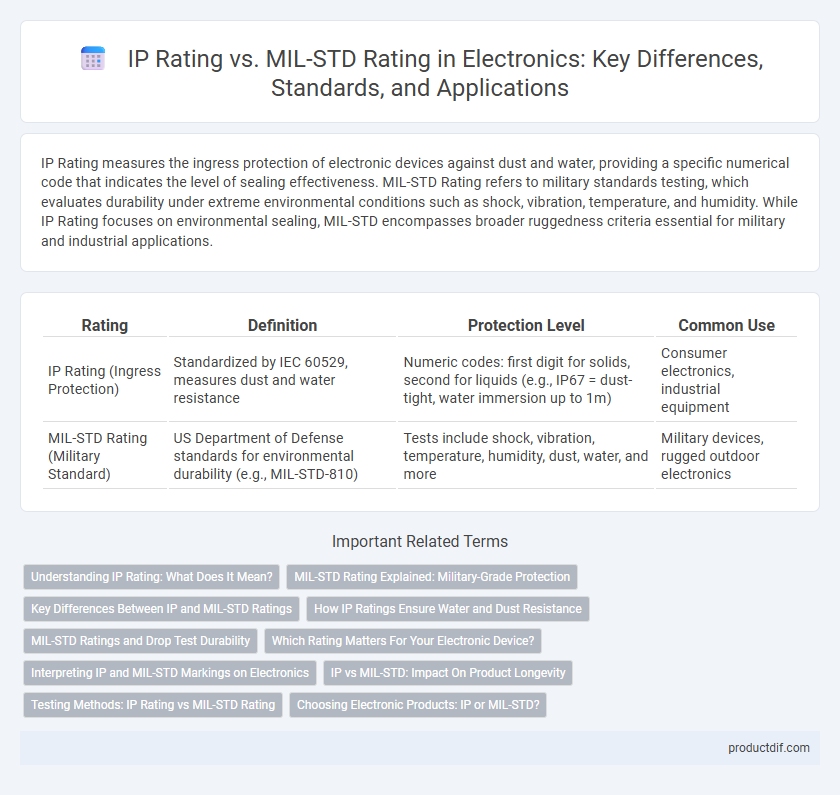IP Rating measures the ingress protection of electronic devices against dust and water, providing a specific numerical code that indicates the level of sealing effectiveness. MIL-STD Rating refers to military standards testing, which evaluates durability under extreme environmental conditions such as shock, vibration, temperature, and humidity. While IP Rating focuses on environmental sealing, MIL-STD encompasses broader ruggedness criteria essential for military and industrial applications.
Table of Comparison
| Rating | Definition | Protection Level | Common Use |
|---|---|---|---|
| IP Rating (Ingress Protection) | Standardized by IEC 60529, measures dust and water resistance | Numeric codes: first digit for solids, second for liquids (e.g., IP67 = dust-tight, water immersion up to 1m) | Consumer electronics, industrial equipment |
| MIL-STD Rating (Military Standard) | US Department of Defense standards for environmental durability (e.g., MIL-STD-810) | Tests include shock, vibration, temperature, humidity, dust, water, and more | Military devices, rugged outdoor electronics |
Understanding IP Rating: What Does It Mean?
IP Rating, or Ingress Protection Rating, categorizes electronic devices based on their resistance to solid particles and liquids, with numbers indicating specific levels of protection against dust and water. The first digit ranges from 0 to 6, representing protection against solids, while the second digit ranges from 0 to 9K, indicating protection against varying degrees of moisture exposure. Understanding IP ratings helps consumers choose electronics suited for environments with dust, splashes, or immersion.
MIL-STD Rating Explained: Military-Grade Protection
MIL-STD Rating refers to the U.S. Department of Defense's military standards, specifying rigorous testing requirements for electronic devices to withstand extreme conditions such as shock, vibration, temperature, and humidity. Unlike IP Ratings, which primarily focus on dust and water ingress protection, MIL-STD standards ensure comprehensive durability and reliability in combat and harsh environments. Devices certified with MIL-STD 810G or 810H demonstrate military-grade protection, making them suitable for defense, industrial, and rugged outdoor applications.
Key Differences Between IP and MIL-STD Ratings
IP ratings focus on protecting electronics from dust and water ingress, using a standardized numeric scale like IP67 or IP68 to indicate specific levels of resistance. MIL-STD ratings, such as MIL-STD-810, assess durability against broader environmental conditions including shock, vibration, temperature extremes, and humidity, tailored for military-grade equipment. The key difference lies in IP ratings targeting ingress protection while MIL-STD covers comprehensive ruggedness testing across multiple physical challenges.
How IP Ratings Ensure Water and Dust Resistance
IP ratings classify electronic devices based on their protection against solid particles like dust and liquids such as water, using a standardized scale defined by the International Electrotechnical Commission (IEC). The first digit in the IP rating indicates dust protection from 0 (no protection) to 6 (dust tight), while the second digit represents water resistance levels from 0 (no protection) to 9K (high-pressure, high-temperature water jets). This precise classification helps manufacturers design electronics with reliable ingress protection, ensuring durability in harsh environments without relying on more complex MIL-STD testing.
MIL-STD Ratings and Drop Test Durability
MIL-STD ratings, specifically MIL-STD-810, provide rigorous testing standards for electronics, focusing on environmental durability, including drop test resilience, vibration, extreme temperatures, and humidity resistance. These military-grade certifications ensure devices withstand harsh conditions beyond standard IP ratings, which primarily measure dust and water ingress protection. Drop test durability under MIL-STD-810 involves multiple controlled impacts from varying heights, ensuring robust structural integrity and reliable performance in demanding operational scenarios.
Which Rating Matters For Your Electronic Device?
IP Rating measures an electronic device's protection against dust and water ingress, crucial for consumer gadgets exposed to everyday environments. MIL-STD Rating evaluates durability under extreme conditions such as shock, vibration, temperature, and humidity, essential for military and industrial electronics. Choosing the proper rating depends on the device's intended use case, with IP Ratings suitable for moisture resistance and MIL-STD Ratings ensuring robust physical and environmental resilience.
Interpreting IP and MIL-STD Markings on Electronics
IP ratings quantify an electronic device's resistance to dust and water ingress, with codes like IP67 indicating complete dust protection and immersion in water up to 1 meter for 30 minutes. MIL-STD ratings, such as MIL-STD-810G, specify military testing procedures including shock, vibration, temperature extremes, and humidity, ensuring durability under harsh environments. Interpreting these markings enables users to select electronics suitable for specific industrial or outdoor applications based on environmental resilience criteria.
IP vs MIL-STD: Impact On Product Longevity
IP ratings quantify a device's protection against dust and water ingress, ensuring durability in specific environmental conditions by defining precise exposure levels. MIL-STD ratings encompass a broader range of environmental and mechanical stress tests, including shock, vibration, temperature extremes, and humidity, providing a comprehensive assessment of product robustness. Devices with MIL-STD certification often demonstrate enhanced product longevity in harsh operational environments compared to those with only IP ratings, due to their resilience against multifaceted physical stresses.
Testing Methods: IP Rating vs MIL-STD Rating
IP Rating testing methods involve controlled exposure to dust and varying degrees of water ingress using standardized enclosures to quantify protection levels, such as IP67 or IP68 specifications. MIL-STD rating employs rigorous military-grade testing protocols including shock, vibration, temperature extremes, humidity, and sand/dust exposure to ensure durability under harsh field conditions. The difference lies in IP testing focusing primarily on ingress protection, while MIL-STD evaluates overall environmental resilience and mechanical robustness.
Choosing Electronic Products: IP or MIL-STD?
Choosing electronic products requires understanding the difference between IP rating and MIL-STD rating to ensure durability and protection. IP ratings categorize resistance to dust and water ingress based on international standards, ideal for consumer electronics exposed to environmental elements. MIL-STD ratings, such as MIL-STD-810, certify devices against rigorous military-grade testing conditions including shock, vibration, and extreme temperatures, making them suitable for harsh industrial and tactical environments.
IP Rating vs MIL-STD Rating Infographic

 productdif.com
productdif.com